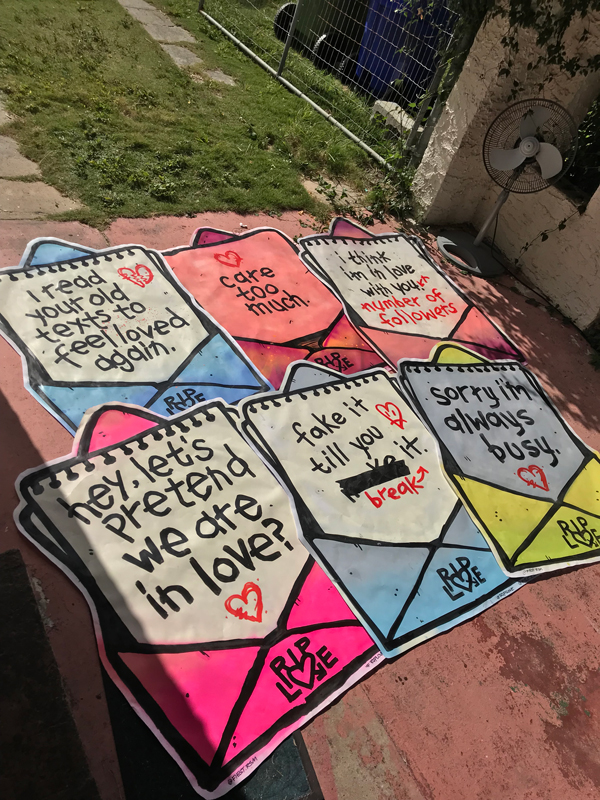Leaving my converted-garage AirBnb near Little Havana, I was charmed to find the walkway was blocked by wheat posters and spray cans. It was 9 a.m. on the second day of Art Basel Miami Beach and artist Fiest was putting the finishing sprays on a series of his RIP LOVE posters: open envelopes with notebook-page messages reading, “hey, let’s pretend we are in love?”, “sorry i’m always busy”, “i read your old texts to feel good again.”
I explained why I was not annoyed that my path was obstructed, and asked if I could take a few photos to post on Artillery’s Instagram. As I tapped my iPhone, the artist and I had this exchange:
“You putting these up tonight?” I asked.
“No. I’m going out in an hour.”
“Brave,” I motioned to the coral-blue sky. “Broad daylight.”
“I can’t put up posters at night,” Fiest said.
“Wow. Huh. I…never thought of that.”
“I’m saying,” Fiest smiled, “because I’m black.”
“No, I got it,” I said to the artist also known as Khalil Gibran. “I never thought of it because of my white privilege.”
And I hadn’t. But I did as I drove towards Miami Beach. I thought that in the nearly 10 years of writing about street and urban art for my Curfew column, I’d never considered the demographics often affected by them. I flipped through my mind’s microfiche to find examples of imposed curfews: Baltimore following the funeral of Freddie Gray; Ferguson, Missouri, following the death of Michael Brown; Los Angeles following the acquittal of Rodney King’s assailants; New Orleans post-Hurricane Katrina.
Fiest had understood that I was both serious and not with my white privilege line (he smirked). He explained, off my questions, that it actually didn’t matter which city he was in: he’d just come from Atlanta, was now in Miami, and, like me, called LA home. Anywhere he went, he said, he had to be mindful that he was a black man committing an illegal act.
I cycled through locations of the street art I’ve liked best in LA: tops of buildings, billboards, alleys. I knew some of the artists behind them. Almost all were white. It was impossible not to wonder how building owners (and the LAPD) would respond to finding Shepard Fairey near their roof turbine and discovering Khalil Gibran up there.
In my column, I’ve often mentioned that the reason I adore urban art is that it doesn’t depend on Eli Broad’s taste—museums are the display cases of rich white men, but walls are egalitarian. This sentiment now needs an asterisk: the walls may be egalitarian, but how they’re policed is not.

